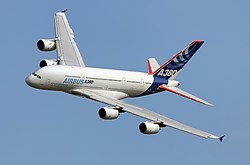This article needs additional citations for verification .(December 2007) |

A double-deck aircraft has two decks for passengers; the second deck may be only a partial deck, and may be above or below the main deck. Most commercial aircraft have one passenger deck and one cargo deck for luggage and ULD containers, but a few have two decks for passengers, typically above or below a third deck for cargo.


